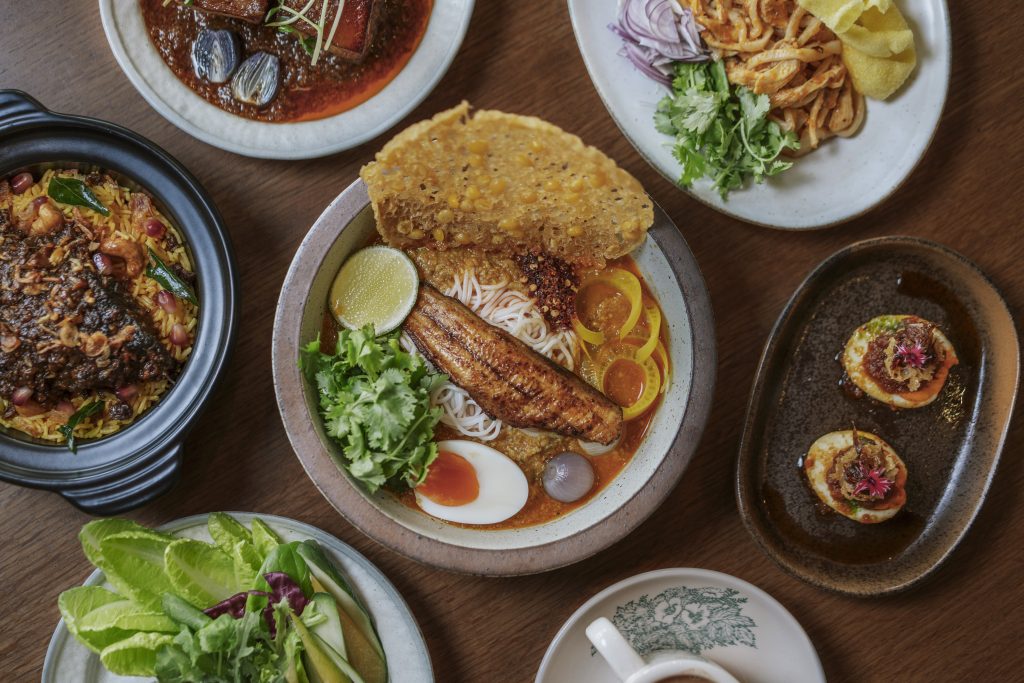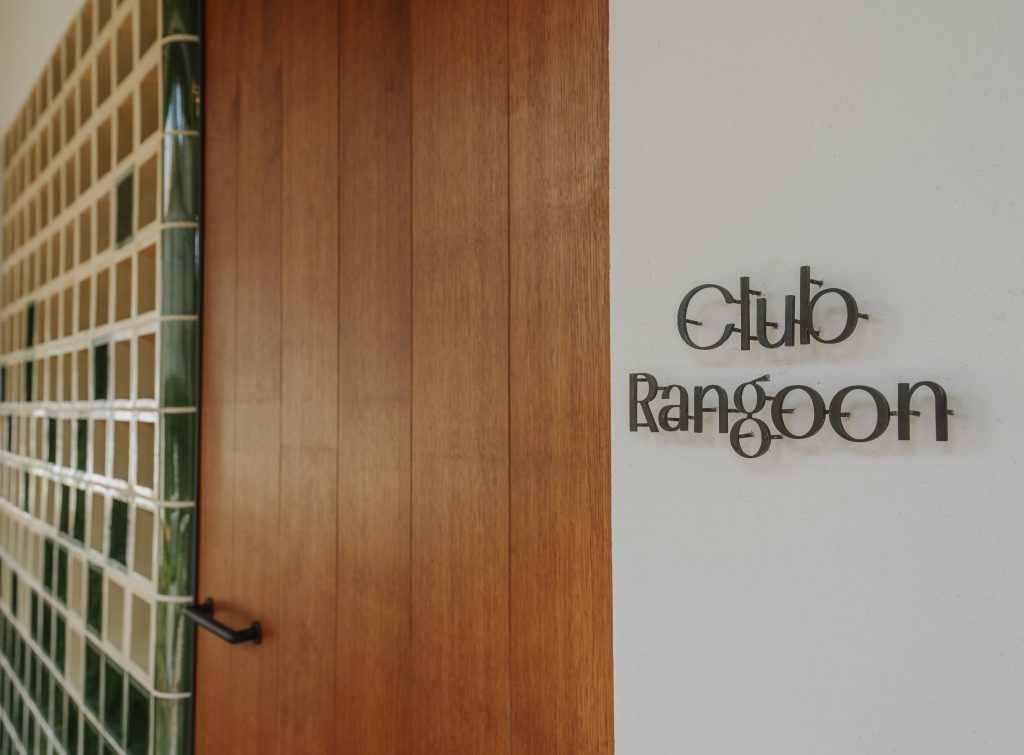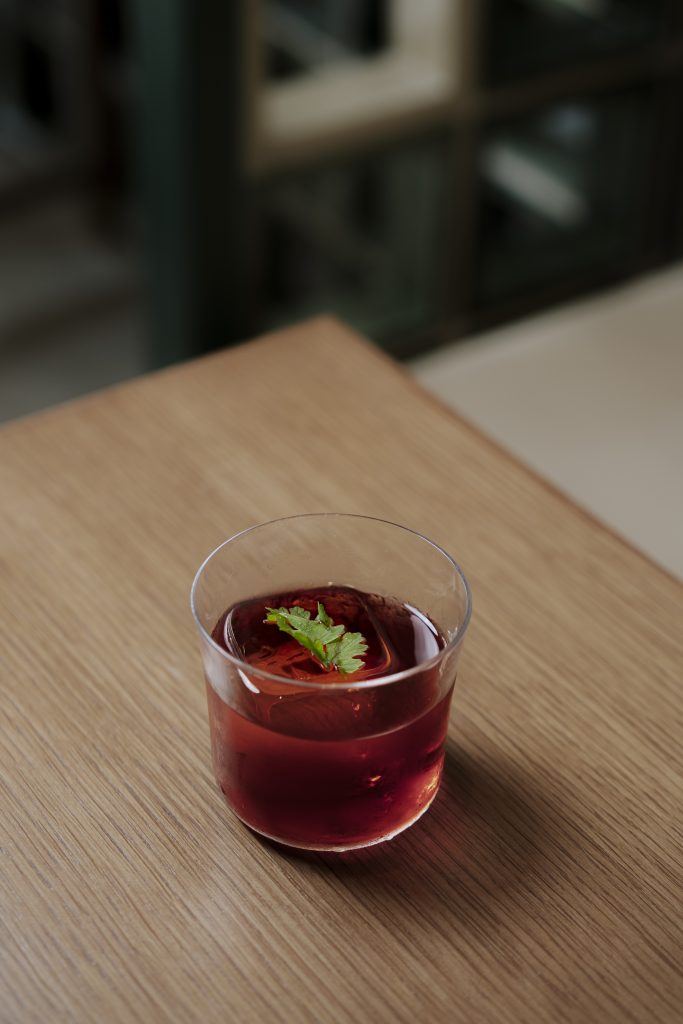
Contemporary Burmese restaurant, Club Rangoon opens on 13 August 2024 in the vibrant Duxton enclave.
Located in a heritage shophouse, the stylish, welcoming 39-seater space is an ode to the Burmese teahouse, a space for gathering over meals. For Burmese co-founder Nelson Htoo (pronounced “Too”), Club Rangoon is also a homecoming — he lived in Singapore during his teens — and a showcase of modern-day Burmese cuisine and culture.
With Chef “Noom” Charrinn Singdaechakarn leading the kitchen, Club Rangoon serves up fresh takes on Yangon classics inspired by Nelson’s family recipes, using authentic Burmese ingredients. The concise menu spotlights the key Burmese flavour pillars — chin (sour), ngan (salty) and sat (spicy). This interplay of flavours can be savoured in familiar dishes such as mohinga, the iconic Burmese noodle soup, and laphet thoke, the ubiquitous Burmese tea leaf salad.
Club Rangoon is Hong Kong-based hospitality group Common Abode’s debut concept in Singapore. Other concepts in Hong Kong, past and present, include Nordic cafe Hjem, casual Thai stall Camp Krapao, and hip hop bar and lounge Candour.
A MENU FOR THE MODERN BURMESE DINER
Club Rangoon seeks to redefine preconceptions of Burmese cuisine through accessible iterations of beloved favourites, in a celebration of authentic flavours that appeal to both the contemporary diner, and the modern Burmese. While Club Rangoon’s menu honours Nelson’s family recipes by using Burmese ingredients where relevant and crucial to the essence of a dish, the greater aim is to show how the country’s cuisine has more in common with familiar Southeast Asian cuisines than not.
A typical Burmese meal features rice, two to three curries, relishes and condiments including ngapi, the fermented fish or shrimp paste that is similar to belacan, usually served as a dip with a platter of fresh vegetables. A salad and soup round off the repast. “Burmese enjoy texture in our food, and we typically combine a bit of rice with the different components of the meal to form a flavourful mouthful,” says Nelson. “Burmese food is really best enjoyed when you have multiple textures and flavours at one go.”
In the Bites section of the menu, for instance, the Shan Htamin Jin ($12.50) features moreish morsels of turmeric rice balls rolled with fermented fish, each topped with a crispy rice pillow filled with tomato paste, and caramelised shallots. It’s served with chive root that you are meant to take a bite of alongside your rice ball morsel for an explosion of flavours and texture.
The Dirty Egg Bites ($12), jammy hard-boiled egg halves topped with a flavourful tomato chilli curry, recall sambal eggs beloved in Malay cuisine — but is in fact Club Rangoon’s riff on the Burmese golden egg curry, featuring pan-fried hard-boiled eggs simmered in a spicy tomato and onion based curry.
Burmese tea sourced from Lucky Tea Leaves — a favourite brand in the Htoo family for over 30 years is also featured in the housemade Laphet-yay Ice Cream ($15). Paired with banana crumble, it is a sweet, refreshing end to your meal.
CROSS-CULTURAL FAVOURITES — FAMILIAR, YET DIFFERENT
“Real Burmese food can vary deeply,” observes Nelson. “With over 130 ethnic groups in Myanmar, our cuisine is also influenced by surrounding cuisines and cultures — from Thailand and Laos, to China and India.” Burmese cuisine is also hyper-local, with recipes varying from town to town, city to city and even family to family, alongside distinct dishes influenced by local states like Shan and Mon.
 The To Share section is a showcase of the cross-cultural influences in Burmese cuisine. The Burmese biryani is celebrated in the show-stopping Wagyu Beef Cheek Dan Bauk ($42). Rather than mutton or chicken usually found in Burmese biryani, Club Rangoon uses Wagyu beef from Australia.
The To Share section is a showcase of the cross-cultural influences in Burmese cuisine. The Burmese biryani is celebrated in the show-stopping Wagyu Beef Cheek Dan Bauk ($42). Rather than mutton or chicken usually found in Burmese biryani, Club Rangoon uses Wagyu beef from Australia.
Served in a claypot, the beef cheek is slow-cooked for five hours and served atop fluffy rice flavoured with saffron and Burmese masala. Fried shallots, curry leaves, cashews and pomegranate seeds add pops of crunch and tang to this rich, comforting rice dish. Similarly, the Wat Thani ($34) or Burmese spicy pork in sweet soy sauce stars unapologetic chunks of fatty pork belly braised till tender in a savoury, spiced gravy.
ICONIC BURMESE DISHES YOU CAN’T MISS
At Club Rangoon, you’ll also find some dishes synonymous with Burmese cuisine. Mohinga ($34) is Myanmar’s unofficial national dish, traditionally eaten at breakfast. Club Rangoon serves up the Yangon version based on the Htoo family’s recipe. Fine, round rice noodles arrive drenched in a hearty, lightly spiced catfish and lemongrass broth with tender pearl onion and banana stems.
The dish is topped with a hard-boiled egg half, grilled catfish fillet, and a savoury chickpea fritter. Squeeze some lime juice and dig into this comforting hug in a bowl.As a significant part of Myanmar’s agriculture, tea or laphet-yay has become embedded in Burmese life and is today considered the country’s national beverage. Tea is drunk before, during and after meals, offered when receiving guests — and eaten as a meal or a snack.
Laphet Thoke ($17), the iconic fermented Burmese tea leaf salad, features tea leaves from popular Burmese tea brand Sein Palaung. Club Rangoon’s version showcases the gentle funk of tea leaves fermented for three months. The leaves are then tossed with a tangy, refreshing mix of radicchio, cabbage and tomatoes. Extra crunch comes from broad beans, garlic chips and roasted peanuts.
A CELEBRATION OF FUNKY UMAMI
Cuisines across Asia are anchored by umami — soy sauce in China, kelp and bonito (combined to make dashi) in Japan, fish sauce in Thailand and Vietnam, and fermented shrimp paste in most of Southeast Asia. Where we have belacan in Singapore and Malaysia, the Burmese have ngapi. Ngapi is the core source of umami in Burmese cuisine and the star ingredient in ngapi yay, the chilli-spiked dip that accompanies the pile of raw vegetables central in every Burmese meal.
Club Rangoon’s Ngapi-yay Toh-Zayar ($12) showcases fermented catfish ngapi in a savoury, spicy dip made with toasted dried shrimp, chilli and shallots. It is served with an array of greens such as cucumber, radish and lettuce.
The Burmese love for fermentation and funk is also the starting point for Club Rangoon’s cocktails. Designed to pair with the food and easy to drink, classic cocktails (from $25) are given a subtle twist with Burmese ingredients.
The Laphet Martini features a fermented tea cordial for umami, while the Nway Ma is a riff on the margarita with a housemade lemongrass cordial and chilli tincture. Nelson’s favourite cocktail, the signature Rangoon Negroni, is rich with peanut oil-washed gin and herbaceous with coriander-infused Campari.
A Gin & Tonic selection ($21 each) also leans into the flavours of Burmese cuisine, including Savoury with fish sauce and fresh ginger paired with a classic tonic, and Spicy with red chilli paired with a grapefruit tonic.
“As a Burmese person, I am extremely proud of my culture and cuisine, which remains elusive to the greater public,” says Nelson. “With Club Rangoon, we hope dishes like mohinga and ngapi will be a deliciously funky introduction to my culture. Singapore’s open-minded dining landscape offers Club Rangoon an opportunity to showcase this.”







